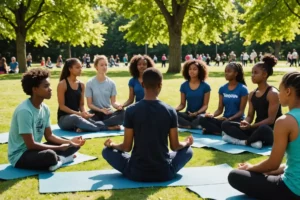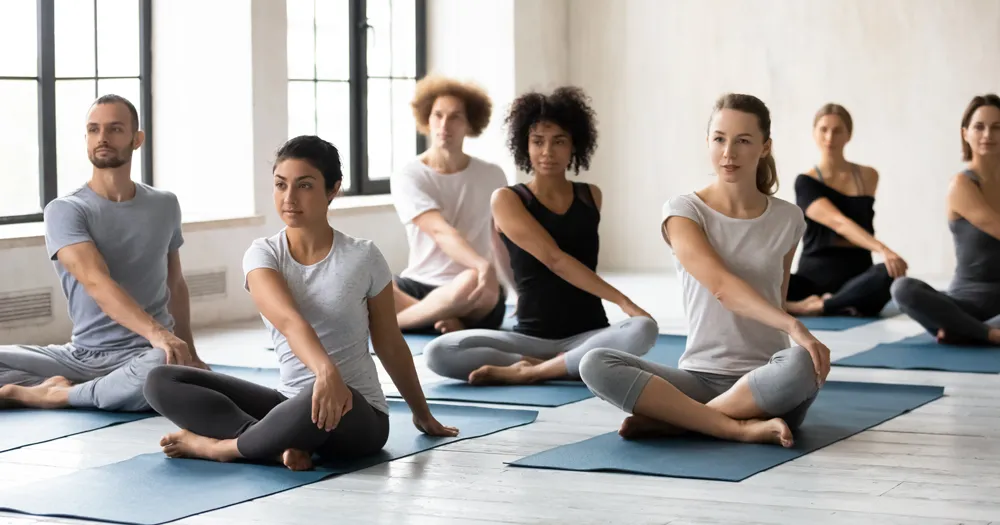Across the globe, a quiet but powerful shift is taking place in classrooms. Yoga—once considered a niche wellness activity—is now becoming a mainstream feature in educational systems, particularly as schools grapple with a surge in teenage stress, anxiety, and mental health struggles. From public schools in the United States and the United Kingdom to institutions in India, Australia, Nigeria, and beyond, educators are increasingly adopting yoga as a structured part of their students’ daily routines.
The rising acceptance of yoga in formal education isn’t just a passing trend. It represents a response to an alarming global mental health crisis among teenagers. Studies show that adolescents are experiencing record-high levels of stress due to academic pressure, social media influence, family instability, economic uncertainty, and post-pandemic adjustments. In response, many educators are turning to yoga as a scientifically backed, non-invasive, and cost-effective tool to support students’ emotional and physical wellbeing.
Mounting Stress Among Teens Demands Urgent Action
Around the world, adolescent mental health has become a growing concern. In the United States, the Centers for Disease Control and Prevention (CDC) reported in 2023 that more than 40% of high school students felt persistently sad or hopeless. In the UK, NHS data revealed that one in six children aged 7 to 16 suffered from a probable mental health disorder. Meanwhile, in Africa and Asia, limited access to professional psychological care has left many teens without support, heightening the need for preventative wellness strategies.
The COVID-19 pandemic exacerbated these challenges. Isolation, disrupted schooling, grief, and family financial hardship created fertile ground for anxiety and depression to take root in young minds. As life returns to a new normal, educators and policy makers have acknowledged that traditional academic models must evolve to include mental health resilience.
This is where yoga, with its blend of physical exercise, mindfulness, and breathing techniques, enters the picture. Not only is it accessible to students of all backgrounds and fitness levels, but it also cultivates emotional regulation, focus, and inner peace—qualities that are increasingly essential in today’s high-pressure environments.

Schools Around the World Leading the Movement
Many schools in the West were among the early adopters of yoga-based education. In the United States, states like California, New York, and Massachusetts have implemented yoga programs in public schools with remarkable outcomes. Students who participate in regular yoga sessions have shown improvements in concentration, self-esteem, classroom behavior, and academic performance. Several school districts now employ certified yoga instructors or offer teacher training for in-house staff to lead sessions.
In the UK, yoga is now part of the Physical Education curriculum in many secondary schools. Some institutions also offer morning mindfulness and yoga assemblies before traditional lessons begin. These practices have helped reduce behavioral issues and absenteeism while promoting a calmer, more cohesive school atmosphere.
Meanwhile, in India—the birthplace of yoga—the practice is returning to classrooms with renewed vigor. Following government endorsement, many Indian schools have formalized yoga instruction in their curriculum, treating it as essential to holistic education. In June each year, schools across the country participate in International Yoga Day, with millions of students performing asanas (postures) and breathing exercises.
In Africa, countries like Nigeria and South Africa have recently embraced yoga as a means of tackling mental health stigma and promoting physical well-being. Private schools in Lagos, Abuja, and Johannesburg have partnered with yoga instructors and NGOs to introduce weekly sessions. These efforts are gradually extending to public institutions, where yoga is seen not just as a luxury but as a necessary intervention in overstretched education systems.
Australia, Canada, and several parts of Europe have also reported success in piloting yoga programs in school settings. With the World Health Organization recognizing yoga’s mental health benefits, international support for its integration in education continues to grow.
Evidence-Based Benefits Drive Acceptance
Skepticism surrounding yoga’s place in schools has diminished significantly, thanks to mounting scientific evidence that validates its impact. Numerous studies published in journals such as The Journal of Adolescent Health and The Journal of School Psychology have shown that school-based yoga interventions significantly reduce symptoms of anxiety, stress, and depression in adolescents.
One study conducted by Harvard Medical School found that teens who practiced yoga for just 30 minutes three times a week reported reduced cortisol levels—the hormone associated with stress. Additionally, participants demonstrated better emotional regulation and fewer behavioral issues in the classroom.
Teachers and school counselors also report that yoga offers students an alternative way to express themselves and decompress without judgment. For children who may struggle with traditional talk therapy or medication, yoga provides a non-verbal, physical form of mental release.
Curriculum Integration and Cultural Adaptation
Integrating yoga into existing educational frameworks requires careful planning, especially in culturally diverse settings. Schools must adapt yoga practices to be inclusive and sensitive to local religious or cultural beliefs. Many institutions have adopted a secular approach, focusing on physical postures, breathing exercises, and mindfulness rather than spiritual elements.
Some schools embed yoga into Physical Education (PE) classes, while others offer it as an elective course or part of homeroom activities. In regions where mental health remains taboo, yoga is introduced under the broader umbrella of wellness, fitness, or concentration-building techniques.
Parents have also warmed up to the idea as they witness positive changes in their children. Many report improved sleep, better mood stability, and more effective coping skills at home.
The Future of Yoga in Education
As schools worldwide continue to innovate and adapt to the complex needs of modern learners, yoga is increasingly viewed not just as a stress-relief tool but as a long-term investment in student development. Institutions are beginning to recognize that academic excellence cannot be separated from emotional health.
Government ministries in several countries are now evaluating policies to support yoga in education formally. International aid organizations and mental health nonprofits have also begun funding yoga teacher training for schools in underserved communities.
Furthermore, digital platforms now allow students to access guided yoga and mindfulness videos even when schools close, ensuring continuity of mental health support in emergencies or remote learning scenarios.
Conclusion: A Mindful Revolution in Learning
The integration of yoga into school curriculums marks a pivotal moment in the global education landscape. As mental health challenges among adolescents reach critical levels, yoga emerges as a practical, effective, and culturally adaptable solution that supports both body and mind.
By teaching students how to breathe, stretch, and center themselves amidst chaos, schools are not only improving academic performance but also nurturing a generation better equipped to face life’s challenges with resilience and compassion. In this new era of mindful education, yoga has transitioned from the fringes to the front lines—helping young people everywhere rediscover balance, peace, and purpose.





